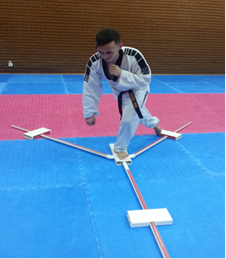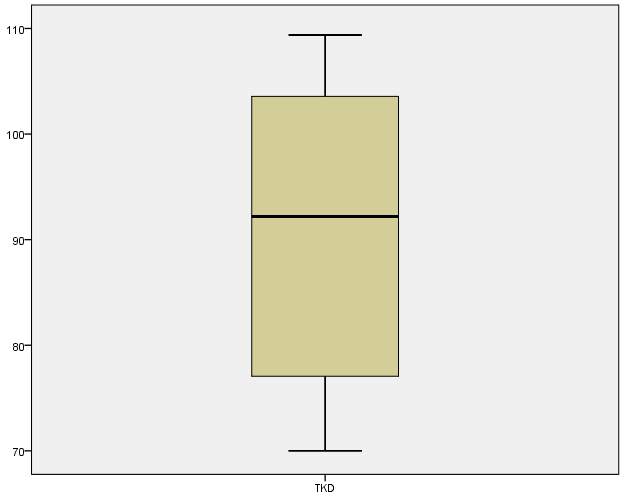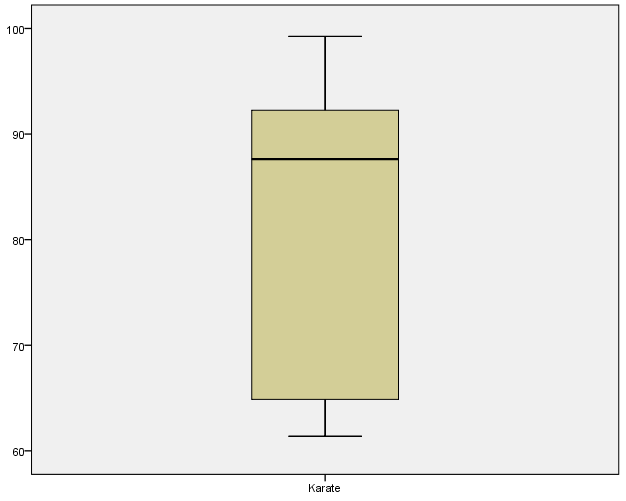Abstract
This research is part of the evaluative research typology. This type refers more to a research goal than to a specific method. It usually focuses on the evaluation or impact of a program or social intervention. The relationship between balance ability and the risk of sports injuries has been proven in many cases, but the relationship between balance ability and sports performance is less elucidated. The objective assessment of taekwondo and karate balance ability was achieved through the Y-Balance Platform, a dynamic foot or hand test that requires strength, flexibility, central control and proprioception. The purpose of this test is to maintain balance on a foot or hand, as far as possible with the other foot or hand in three different directions. The research was carried out on 16 students from the representative taekwondo and karate teams of the “Carol Davila” University of Medicine and Pharmacy (UMF), aged 19-26. The purpose of the research is to evaluate the ability to manifest dynamic balance in the two sports, as well as to compare this ability in the lower and upper limbs. The goal is to establish the balance performance level in taekwondo and karate athletes. Thus, in the right lower leg, the right upper and lower ante-medial limb, taekwondo athletes have achieved a better average compared to those who practice karate, with a confidence interval that does not contain 0.00, the difference being statistically significant at a two-tailed significance level of 5%.
Keywords: Taekwondokaratebalancesportssports performance
Introduction
The term “equilibrium” comes from the Greek words
Epuran and Horghidan (1994), addressing the issue of psychomotricity, place together body schema, laterality, rapidity of movements, ideomotricity, dynamic coordination and static coordination – balancing. Postural stability and dynamic balance may represent gradual indicators of neurological dysfunction or exceptional skills for performance rifle shooting, circus art or special professions, provided that they are objectively measured (Păunescu, Păunescu, & Mircică, 2017).
Balance ability is closely related to speed, strength and mobility, being of great importance in the acquisition and improvement of the technique and tactics, as well as in competition tests in the two sports, Kyorugi (fight) and Kata (form). All taekwondo (TKD) techniques involve the whole body working in a balanced and coordinated way, resulting in a natural position and economic movements at all levels (Păunescu, 2013). In the karate fight, it is impossible to self-defend and attack in a precise order; the movements are free, yet consist in a certain purity that exists only in kata (Macoveanu, 1996). The most significant techniques for assessing these abilities are kinaesthetic sensitivity (measured with the kinesimeter) and the sense of balance. The latter can be measured for: static balance (which refers to the ability of holding a stationary position); dynamic balance (which refers to the ability of achieving and holding a proper position during movement) (Tudor, 2005).
Problem Statement
According to Hrysomallis (2011), the relationship between balance ability and sports injury risk has been demonstrated in many cases, but the relationship between balance ability and sports performance is less clear. This quantitative analysis compares the balance ability of athletes practicing different sports, determines whether there are differences in the balance ability of athletes at various competition levels within the same sport, identifies the relationship of balance ability with performance measures and examines the influence of balance training on sports performance or motor skills.
Thus, several studies have found that poor balance ability is significantly related to an increased risk of ankle injuries in different sports activities, and this relation seems to be more common in males than females. After using games with different equilibrium exercises, over 12 weeks (Cosma, Rusu, Ilinca, & Nanu, 2016), for children aged 6-7 years, changes in the balance of tested subjects demonstrate their influence on the experimental intervention module effectiveness in developing psychomotor skills, the average progress being 32.17% balance on the right foot and 33.16% on the left foot.
Prospective studies suggested that adding a balance training component to the activities of recreationally active subjects or physical education students resulted in improvements in vertical jump, agility, shuttle run and downhill slalom skiing (Păunescu et al., 2017). In the literature, there is little evidence of the influence of balance training on the motor skills of elite athletes, the balance ability being correlated with the level of competition, more experienced athletes having better balance ability.
Zago et al. (2015) suggest that elite karateka have shown a refined dynamic balance control obtained through the increase of the support base and different manoeuvres of lower limbs. In their turn, Cromwell, Meyers, Meyers, & Newton (2007) underline that improving balance and walking ability through Tae Kwon Do exercise may serve to restore function that has declined with age and preserve mobility for older adults.
Research Questions
Given the complexity of the field, including the various influences of socio-demographic variables, the present study asks whether there are significant associations or differences between the balance ability of kyorugi taekwondo athletes and karate athletes participating only in kata competitions. Thus, the hypothesis to be tested is H1: There are significant differences in the manifestation of the dynamic balance ability between taekwondo athletes and those practicing karate.
Purpose of the Study
The purpose of the research is to evaluate the ability to manifest dynamic balance in the two sports, as well as to compare this ability in the lower and upper limbs.
Research Methods
Participants
The research was carried out on 16 students from the representative taekwondo and karate teams of the “Carol Davila” University of Medicine and Pharmacy (UMF), aged 19-26. Subjects practicing taekwondo participate only in the kyorugi test (fight), while students from the representative karate team participate in competitions only in the kata test (form). Specifically, in taekwondo, we have multiple national champions and third-ranked European champions, while in karate there are athletes with national results as champions and vice-champions, but also two European vice-champions and one world vice-champion.
Materials
In this research, the objective assessment of balance ability in karate and taekwondo was achieved through the Y-Balance platform (Figure

Procedure
The starting position for the lower limb is with a foot on the plate, the toes on the red line, and the other foot tapping slightly with the tiptoes on the red side of the plate. The free foot is moved in the desired direction, pushing the pointer as far as possible while maintaining balance. The free foot must be brought back to the starting position under control, without touching the ground.
The starting position for the upper limb is supported forward by a hand on the plate, with the thumb on the red line, the other hand tapping the red side of the plate with the fingertips. The free hand is carried in the desired direction, pushing the pointer as far as possible while maintaining balance so that the free hand is brought back to the starting position under control, without touching the ground.
Findings
Descriptive statistics
In the preliminary data analysis, we made a descriptive statistic of the results for the two separate samples Tables

It is noted that, in taekwondo athletes, the median of the data (the centre line in the box) is not at the centre of the box, having a positive asymmetry in the lower value (Figure

The above representation (Figure
Comparing the results of the two samples
To verify the association or significant differences between variables (results for the two limbs, according to the sport branch), the
Regarding the results obtained by athletes according to the sport practiced, statistics show that the closest mean of the results has been achieved for the left lower limb, the left upper limb in the postero-medial direction, the right upper limb in the lateral and postero-medial directions (+/-0.5-8 cm). As the confidence intervals for these results contain 0.00 value, the difference is statistically insignificant at a 2-tailed significance level of 5%. Also in the above table, it is noted that, for the right lower leg, the right upper and lower ante-medial limb, taekwondo athletes have achieved a better average compared to those who practice karate, with a confidence interval that does not contain 0.00, the difference being statistically significant at a two-tailed significance level of 5%.
Conclusion
In our research, according to the sport practiced, statistics show that the closest average of the results has been achieved for the left lower limb, the left upper limb in the postero-medial direction, the right upper limb in the lateral and postero-medial directions, while for the right lower limb, the right and left upper limbs in the antero-medial direction, the athletes participating in kyorugi have achieved a better average compared to those participating in kata events.
Thus, we can argue that, in the case of subjects tested by us, there are differences between taekwondo and karate athletes in balance ability for the right lower limb, the right and left upper limbs in the antero-medial direction.
References
- Cosma, G., Rusu, L., Ilinca, I., & Nanu, C. (2016). Improving the pupils’ balance through rhythmic and movement games. The European Proceedings of Social and Behavioural Sciences, XI, 320-325. Retrieved from http://dx.doi.org/10.15405/epsbs.2016.06.44
- Cromwell, R., Meyers, M. P., Meyers, E. P., & Newton, R. (2007). Tae Kwon Do: An effective exercise for improving balance and walking ability in older adults. The Journals of Gerontology, 62(6), 641-646.
- Epuran, M., & Horghidan, V. (1994). Psihologia educației fizice. București: ANEFS.
- Gagea, A. (2010). Tratat de cercetare ştiinţifică în educaţie fizică şi sport. București: Discobolul.
- Hrysomallis, C. (2011). Balance ability and athletic performance. Sports Medicine, 41(3), 221-232.
- Macoveanu, D. (1996). Karate Shotokan pentru avansați. Garell Publishing House.
- Păunescu, C. (2013). Taekwondo (Manual). București: Editura Didactică și Pedagogică.
- Păunescu, M., Păunescu, C., & Mircică, M. L. (2017). Balance ability in performance sports. A perspective on scientific studies. 4th International Multidisciplinary Scientific Conference on Social Sciences and Arts (SGEM), Conference Proceedings (Book 3, Vol. 4, pp. 55-62). Retrieved from https://sgemworld.at/ssgemlib/spip.php?article4139
- Şerbănoiu, S. (2002). Capacităţile coordinative în sportul de performanţă. Bucureşti: AFIR.
- Tudor, V. (2005). Măsurare şi evaluare în cultură fizică şi sport. Bucureşti: Alpha MDN.
- Zago, M., Mapelli, A., Shirai, Y. F., Ciprandi, D., Lovecchio, N., Galvani, C., & Sforza, C. (2015). Dynamic balance in elite karateka. Journal of Electromyography and Kinesiology, 25(6), 894-900.
Copyright information

This work is licensed under a Creative Commons Attribution-NonCommercial-NoDerivatives 4.0 International License.
About this article
Publication Date
16 February 2019
Article Doi
eBook ISBN
978-1-80296-054-9
Publisher
Future Academy
Volume
55
Print ISBN (optional)
-
Edition Number
1st Edition
Pages
1-752
Subjects
Sports, sport science, physical education
Cite this article as:
Mircică, M. L., Grigore, V., & Păunescu, C. (2019). Comparative Study On The Manifestation Of Balance Ability In Taekwondo And Karate. In V. Grigore, M. Stănescu, M. Stoicescu, & L. Popescu (Eds.), Education and Sports Science in the 21st Century, vol 55. European Proceedings of Social and Behavioural Sciences (pp. 377-384). Future Academy. https://doi.org/10.15405/epsbs.2019.02.47
